Skyler Wang
NLLB Team
On the Role of Speech Data in Reducing Toxicity Detection Bias
Nov 12, 2024



Abstract:Text toxicity detection systems exhibit significant biases, producing disproportionate rates of false positives on samples mentioning demographic groups. But what about toxicity detection in speech? To investigate the extent to which text-based biases are mitigated by speech-based systems, we produce a set of high-quality group annotations for the multilingual MuTox dataset, and then leverage these annotations to systematically compare speech- and text-based toxicity classifiers. Our findings indicate that access to speech data during inference supports reduced bias against group mentions, particularly for ambiguous and disagreement-inducing samples. Our results also suggest that improving classifiers, rather than transcription pipelines, is more helpful for reducing group bias. We publicly release our annotations and provide recommendations for future toxicity dataset construction.
The Multiple Dimensions of Spuriousness in Machine Learning
Nov 07, 2024Abstract:Learning correlations from data forms the foundation of today's machine learning (ML) and artificial intelligence (AI) research. While such an approach enables the automatic discovery of patterned relationships within big data corpora, it is susceptible to failure modes when unintended correlations are captured. This vulnerability has expanded interest in interrogating spuriousness, often critiqued as an impediment to model performance, fairness, and robustness. In this article, we trace deviations from the conventional definition of statistical spuriousness-which denotes a non-causal observation arising from either coincidence or confounding variables-to articulate how ML researchers make sense of spuriousness in practice. Drawing on a broad survey of ML literature, we conceptualize the "multiple dimensions of spuriousness," encompassing: relevance ("Models should only use correlations that are relevant to the task."), generalizability ("Models should only use correlations that generalize to unseen data"), human-likeness ("Models should only use correlations that a human would use to perform the same task"), and harmfulness ("Models should only use correlations that are not harmful"). These dimensions demonstrate that ML spuriousness goes beyond the causal/non-causal dichotomy and that the disparate interpretative paths researchers choose could meaningfully influence the trajectory of ML development. By underscoring how a fundamental problem in ML is contingently negotiated in research contexts, we contribute to ongoing debates about responsible practices in AI development.
Towards Privacy-Aware Sign Language Translation at Scale
Feb 14, 2024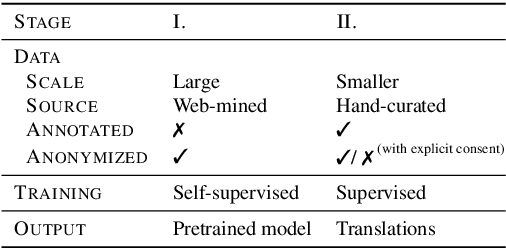


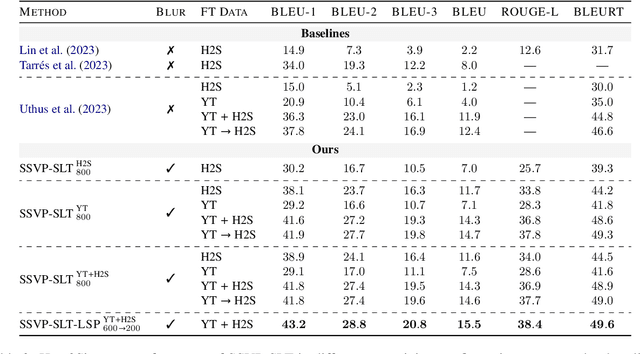
Abstract:A major impediment to the advancement of sign language translation (SLT) is data scarcity. Much of the sign language data currently available on the web cannot be used for training supervised models due to the lack of aligned captions. Furthermore, scaling SLT using large-scale web-scraped datasets bears privacy risks due to the presence of biometric information, which the responsible development of SLT technologies should account for. In this work, we propose a two-stage framework for privacy-aware SLT at scale that addresses both of these issues. We introduce SSVP-SLT, which leverages self-supervised video pretraining on anonymized and unannotated videos, followed by supervised SLT finetuning on a curated parallel dataset. SSVP-SLT achieves state-of-the-art finetuned and zero-shot gloss-free SLT performance on the How2Sign dataset, outperforming the strongest respective baselines by over 3 BLEU-4. Based on controlled experiments, we further discuss the advantages and limitations of self-supervised pretraining and anonymization via facial obfuscation for SLT.
Seamless: Multilingual Expressive and Streaming Speech Translation
Dec 08, 2023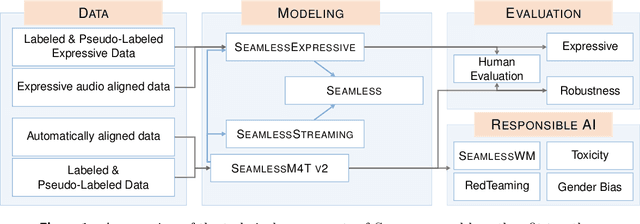
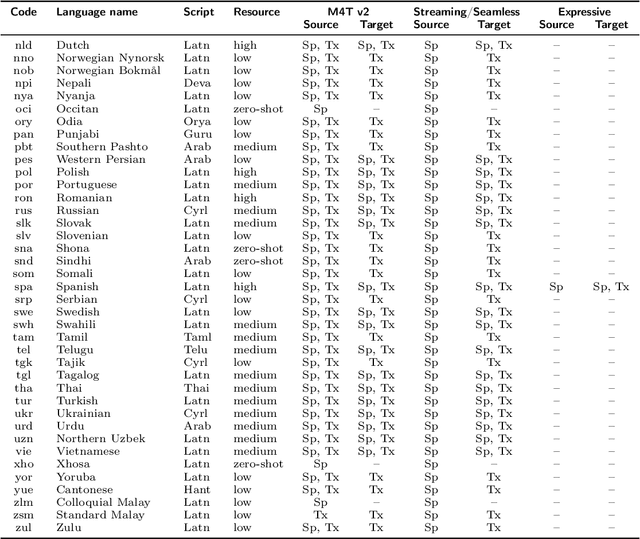

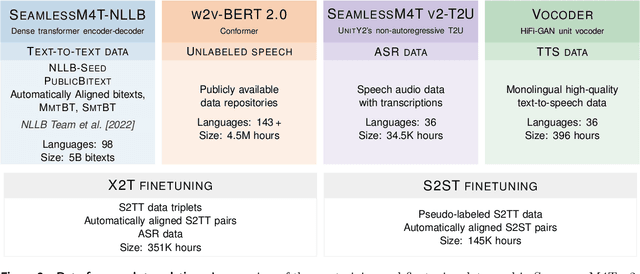
Abstract:Large-scale automatic speech translation systems today lack key features that help machine-mediated communication feel seamless when compared to human-to-human dialogue. In this work, we introduce a family of models that enable end-to-end expressive and multilingual translations in a streaming fashion. First, we contribute an improved version of the massively multilingual and multimodal SeamlessM4T model-SeamlessM4T v2. This newer model, incorporating an updated UnitY2 framework, was trained on more low-resource language data. SeamlessM4T v2 provides the foundation on which our next two models are initiated. SeamlessExpressive enables translation that preserves vocal styles and prosody. Compared to previous efforts in expressive speech research, our work addresses certain underexplored aspects of prosody, such as speech rate and pauses, while also preserving the style of one's voice. As for SeamlessStreaming, our model leverages the Efficient Monotonic Multihead Attention mechanism to generate low-latency target translations without waiting for complete source utterances. As the first of its kind, SeamlessStreaming enables simultaneous speech-to-speech/text translation for multiple source and target languages. To ensure that our models can be used safely and responsibly, we implemented the first known red-teaming effort for multimodal machine translation, a system for the detection and mitigation of added toxicity, a systematic evaluation of gender bias, and an inaudible localized watermarking mechanism designed to dampen the impact of deepfakes. Consequently, we bring major components from SeamlessExpressive and SeamlessStreaming together to form Seamless, the first publicly available system that unlocks expressive cross-lingual communication in real-time. The contributions to this work are publicly released and accessible at https://github.com/facebookresearch/seamless_communication
SeamlessM4T-Massively Multilingual & Multimodal Machine Translation
Aug 23, 2023
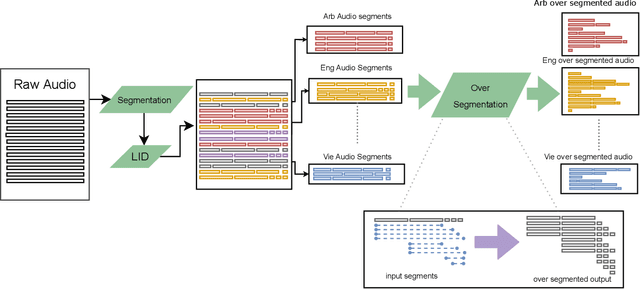
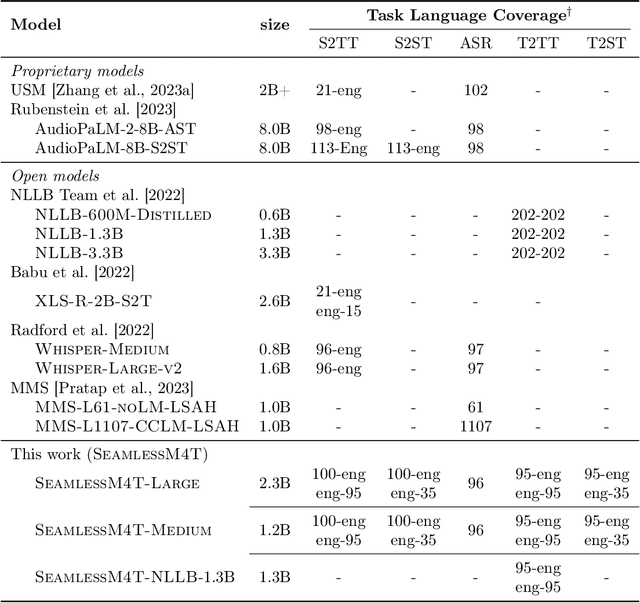
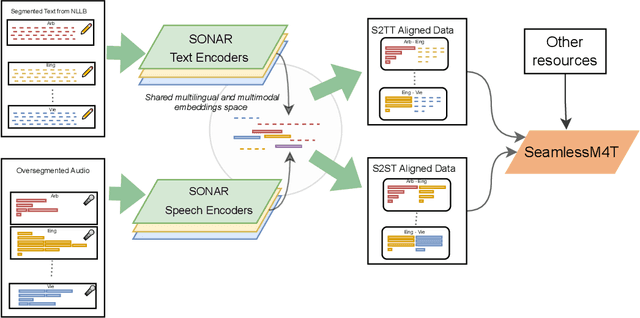
Abstract:What does it take to create the Babel Fish, a tool that can help individuals translate speech between any two languages? While recent breakthroughs in text-based models have pushed machine translation coverage beyond 200 languages, unified speech-to-speech translation models have yet to achieve similar strides. More specifically, conventional speech-to-speech translation systems rely on cascaded systems that perform translation progressively, putting high-performing unified systems out of reach. To address these gaps, we introduce SeamlessM4T, a single model that supports speech-to-speech translation, speech-to-text translation, text-to-speech translation, text-to-text translation, and automatic speech recognition for up to 100 languages. To build this, we used 1 million hours of open speech audio data to learn self-supervised speech representations with w2v-BERT 2.0. Subsequently, we created a multimodal corpus of automatically aligned speech translations. Filtered and combined with human-labeled and pseudo-labeled data, we developed the first multilingual system capable of translating from and into English for both speech and text. On FLEURS, SeamlessM4T sets a new standard for translations into multiple target languages, achieving an improvement of 20% BLEU over the previous SOTA in direct speech-to-text translation. Compared to strong cascaded models, SeamlessM4T improves the quality of into-English translation by 1.3 BLEU points in speech-to-text and by 2.6 ASR-BLEU points in speech-to-speech. Tested for robustness, our system performs better against background noises and speaker variations in speech-to-text tasks compared to the current SOTA model. Critically, we evaluated SeamlessM4T on gender bias and added toxicity to assess translation safety. Finally, all contributions in this work are open-sourced and accessible at https://github.com/facebookresearch/seamless_communication
Prompting Multilingual Large Language Models to Generate Code-Mixed Texts: The Case of South East Asian Languages
Mar 30, 2023



Abstract:While code-mixing is a common linguistic practice in many parts of the world, collecting high-quality and low-cost code-mixed data remains a challenge for natural language processing (NLP) research. The proliferation of Large Language Models (LLMs) in recent times compels one to ask: can these systems be used for data generation? In this article, we explore prompting multilingual LLMs in a zero-shot manner to create code-mixed data for five languages in South East Asia (SEA) -- Indonesian, Malay, Chinese, Tagalog, Vietnamese, as well as the creole language Singlish. We find that ChatGPT shows the most potential, capable of producing code-mixed text 68% of the time when the term "code-mixing" is explicitly defined. Moreover, both ChatGPT's and InstructGPT's (davinci-003) performances in generating Singlish texts are noteworthy, averaging a 96% success rate across a variety of prompts. Their code-mixing proficiency, however, is dampened by word choice errors that lead to semantic inaccuracies. Other multilingual models such as BLOOMZ and Flan-T5-XXL are unable to produce code-mixed texts altogether. By highlighting the limited promises of LLMs in a specific form of low-resource data generation, we call for a measured approach when applying similar techniques to other data-scarce NLP contexts.
No Language Left Behind: Scaling Human-Centered Machine Translation
Jul 11, 2022
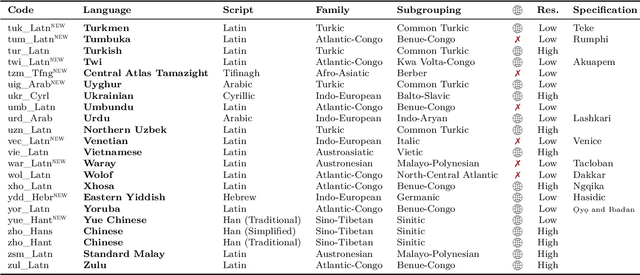
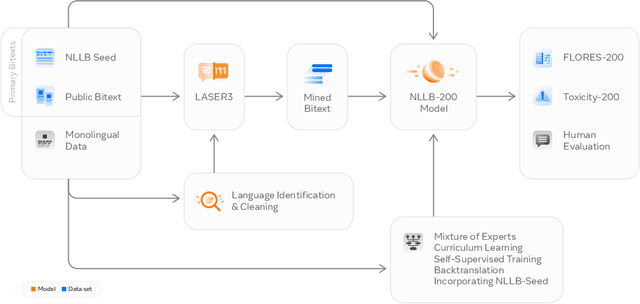

Abstract:Driven by the goal of eradicating language barriers on a global scale, machine translation has solidified itself as a key focus of artificial intelligence research today. However, such efforts have coalesced around a small subset of languages, leaving behind the vast majority of mostly low-resource languages. What does it take to break the 200 language barrier while ensuring safe, high quality results, all while keeping ethical considerations in mind? In No Language Left Behind, we took on this challenge by first contextualizing the need for low-resource language translation support through exploratory interviews with native speakers. Then, we created datasets and models aimed at narrowing the performance gap between low and high-resource languages. More specifically, we developed a conditional compute model based on Sparsely Gated Mixture of Experts that is trained on data obtained with novel and effective data mining techniques tailored for low-resource languages. We propose multiple architectural and training improvements to counteract overfitting while training on thousands of tasks. Critically, we evaluated the performance of over 40,000 different translation directions using a human-translated benchmark, Flores-200, and combined human evaluation with a novel toxicity benchmark covering all languages in Flores-200 to assess translation safety. Our model achieves an improvement of 44% BLEU relative to the previous state-of-the-art, laying important groundwork towards realizing a universal translation system. Finally, we open source all contributions described in this work, accessible at https://github.com/facebookresearch/fairseq/tree/nllb.
 Add to Chrome
Add to Chrome Add to Firefox
Add to Firefox Add to Edge
Add to Edge